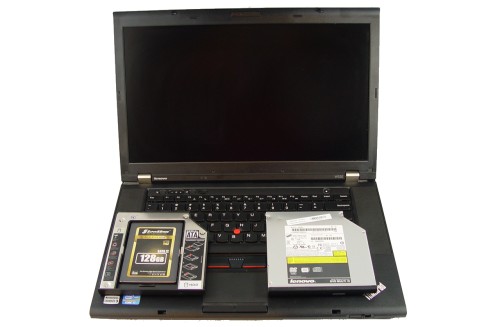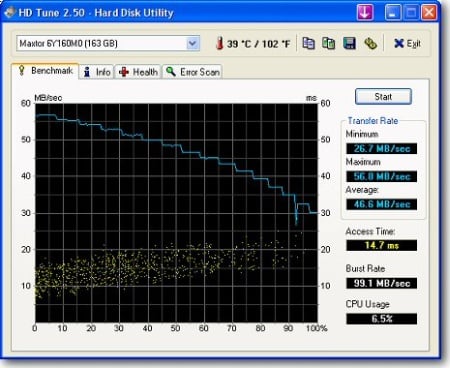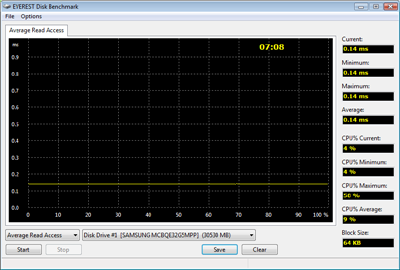Introduction
It's been quite some time since we looked at a Silicon Power SSD even though they were one of the first companies to enter the SSD market. Quietly through the years Silicon Power has released quite a number of SSDs. Its early products were very exciting especially some of the SLC releases that paired Indilinx and Jmicron controllers with single-level cell flash.
The new Silicon Power Slim S70 SSD keeps the excitement going. This is the first retail drive to hit our lab with firmware 5.0.4 already on it. It's also one of the few SandForce based drives shipping in a 7mm form factor for ultrabook use. The price is also attractive, but we've seen better in the past.
Let's dig right in and take a look at the specification before we see the drive. We'll then run the S70 through our new benchmark tests and see how it performs.
Specifications, Pricing and Availability
Silicon Power doesn't give us a whole lot of info on the spec sheet, but the official product page is loaded with information. The Slim S70 ships in four capacity sizes - 60GB, 120GB, 240GB and a large 480GB. The S70 is Silicon Power's 7mm z-height model as opposed to the V-Series products that are 9.5mm tall. We're looking at the fastest capacity size today, 240GB.
With the motto, re-write your SSD experience, the Silicon Power S70 pairs LSI SandForce's SF-2281 controller with Intel 25nm synchronous flash to produce a high-speed user experience. The claimed sequential read speed is 557MB/s and the sequential write speed is 507MB/s. The claimed write speed is lower than many of the other similarly configured drives on the market, but in our testing we found Silicon Power sandbagged a bit. We also found the claimed 4K random write IOPS performance to be low as well. We achieved much higher results.
Silicon Power's accessory package is thin. You get the drive, a paper manual and a set of screws for installing your drive. The screws are a little odd since you don't get a desktop adapter bracket. The warranty is stretched to three years, but that's average these days.
At first we had a difficult time finding the Slim S70 for sale. Google Shopping came up empty, but Amazon saved the day with the 240GB listed at $199 and the 120GB at $99. The prices aren't exceptional, but they are not bad either.
Let's take a look at everything and see how the drive performance and see what the Slim is all about.
Packaging
Silicon Power put together an attractive package for the S70. Hopefully we eventually see this drive enter the brick and mortar market because SP checked all of the right boxes on the package.
We found information all over the package and Silicon Power hit every detail. At the top of the box on the right hand side there is a link, www.silicon-power.com/spm. The text says go there for Amazing Prizes for FREE, but when we visited the link we didn't find anything other than a forbidden message.
The inner packaging keeps the drive away from the package of screws and everything fits together well.
Silicon Power S70 240GB SSD
Here we get our first look at the actual drive. Silicon Power used a nice brushed aluminum case for this series.
The back is basic black and void of a data label. The bottom and side mounting points don't change even with the 7mm package.
Here we see why the Slim is the Slim S70. Silicon Power needed a 7mm model to compete in the aftermarket Ultrabook space. Unlike the 5mm form factor that'll make an appearance next year, the 7mm z-height drives are backwards compatible with standard notebook drives that are 9.5mm tall.
The SATA power and data connectors are the same with 7mm. One thing I do want to point out, Silicon Power's aluminum case is sturdy unlike some of the other 7mm products we've seen. The SATA data cable works smoothly in this drive while on some of the other 7mm drives it's difficult to remove the cable.
Inside we found a LSI SandForce SF-2281 controller and it's paired with sixteen Intel 25nm synchronous flash chips. On Silicon Power's official webpage for the S70 we found a couple of statements that say Toggle/synchronous flash.
We're not sure if Silicon Power has two different designs with different flash under the same model name or if every drive ships with Intel ONFi flash.
Here we see the other eight Intel flash chips.
Benchmarks - Test System Setup and ATTO Baseline Performance
Desktop Test System
Lenovo W530 - Mobile Workstation

Tests performed in this review come from two different systems. The standard tests come from our new desktop system and our new tests found at the end of the review come from the Lenovo W530. The Lenovo tests represent typical notebook performance with the review product running with an operating system on the drive.
ATTO Baseline Performance
Version and / or Patch Used: 2.34
ATTO is used by many disk manufacturers to determine the read and write speeds that will be presented to customers.
In ATTO we achieved 555MB/s read performance and 534MB/s write performance. The write performance on our test system is higher than Silicon Power's claimed performance, but the read speed is a little lower.
Benchmarks - Sequential Performance
HD Tune Pro
Version and / or Patch Used: 4.00
Developer Homepage: http://www.efdsoftware.com
Product Homepage: http://www.hdtune.com
HD Tune is a Hard Disk utility which has the following functions:
Benchmark: measures the performance
Info: shows detailed information
Health: checks the health status by using SMART
Error Scan: scans the surface for errors
Temperature display
HD Tune Pro gives us accurate read, write and access time results and for the last couple of years has been gaining popularity amongst reviewers. It is now considered a must have application for storage device testing.

Starting with a clean drive we start rolling through our tests to move the drive into a dirty state. Reading data sequentially we recorded an average read speed of 415MB/s on the S70.
Our first write test shows a 416MB/s average when writing compressible data across the S70.
Benchmarks - AIDA64 Random Access Time
AIDA64 Random Access Time
Version and / or Patch Used: 1.60
Developer Homepage: http://www.aida64.com
Product Homepage: http://www.aida64.com

AIDA64 offers several different benchmarks for testing and optimizing your system or network. The Random Access test is one of very few if not only that will measure hard drives random access times in hundredths of milliseconds as oppose to tens of milliseconds.
Drives with only one or two tests displayed in the write test mean that they have failed the test and their Maximum and possibly their Average Scores were very high after the cache fills. This usually happens only with controllers manufactured by JMicron and Toshiba.
Manufacturers like to talk about their big number sequential performance, but the most noticeable performance increase over a spinner is how fast actions happen. Read latency is the measurement used to quantify these actions. The Silicon Power Slim S70 produced a .15ms average that spanned the entire length of the drive.
SandForce doesn't use a DRAM buffer to artificially reduce write latency. The Silicon Power S70 produced .18ms latency when writing 64KB blocks to the drive.
Benchmarks - CrystalDiskMark
CrystalDiskMark
Version and / or Patch Used: 3.0 Technical Preview
Developer Homepage: http://crystalmark.info
Product Homepage: http://crystalmark.info/software/CrystalDiskMark/index-e.html
Download here: http://crystaldew.info/category/software/crystaldiskmark
CrystalDiskMark is a disk benchmark software that allows us to benchmark 4K and 4K queue depths with accuracy.
Key Features:-
* Sequential reads/writes
* Random 4KB/512KB reads/writes
* Text copy
* Change dialog design
* internationalization (i18n)
Note: Crystal Disk Mark 3.0 Technical Preview was used for these tests since it offers the ability to measure native command queuing at 4 and 32.
In CDM we discovered typical SandForce 4K performance with near 40MB/s at one request and that jumped to 65MB/s with QD4.
The same was true with the 4K writes. In this test we recorded 136MB/s with one request and that jumped to 267MB/s with QD4. This test uses incompressible data; we'll look at compressible data later in this review.
Benchmarks - PCMark Vantage Hard Disk Tests
PCMark Vantage - Hard Disk Tests
Version and / or Patch Used: 1.0.0
Developer Homepage: http://www.futuremark.com
Product Homepage: http://www.futuremark.com/benchmarks/pcmark-vantage/

PCMark Vantage is the first objective hardware performance benchmark for PCs running 32 and 64 bit versions of Microsoft Windows Vista. PCMark Vantage is perfectly suited for benchmarking any type of Microsoft Windows Vista PC from multimedia home entertainment systems and laptops to dedicated workstations and high-end gaming rigs. Regardless of whether the benchmarker is an artist or an IT Professional, PCMark Vantage shows the user where their system soars or falls flat, and how to get the most performance possible out of their hardware. PCMark Vantage is easy enough for even the most casual enthusiast to use yet supports in-depth, professional industry grade testing.
FutureMark has developed a good set of hard disk tests for their PCMark Vantage Suite. Windows users can count on Vantage to show them how a drive will perform in normal day to day usage scenarios. For most users these are the tests that matter since many of the old hat ways to measure performance have become ineffective to measure true Windows performance.
HDD1 - Windows Defender
HDD2 - Gaming
HDD3 - Windows Photo Gallery
HDD4 - Vista Startup
HDD5 - Windows Movie Maker
HDD6 - Windows Media Center
HDD7 - Windows Media Player
HDD8 - Application Loading
PC Mark Vantage with the drives empty shows very good performance that's competitive with our list of the fastest SSDs in the world. The Silicon Power S70 manages to keep pace and even wins the Windows Media Center test.
Benchmarks - PCMark Vantage - Drives with Data Testing
For a complete breakdown on the Drives with Data Testing please read this article. You will be able to perform this test at home with the files provided in the article - full instructions are included.
- Brief Methodology
SSDs perform differently when used for a period of time and when data is already present on the drive. The purpose of the Drives with Data testing is to show how a drive performs in these 'dirty' states. SSDs also need time to recover, either with TRIM or onboard garbage collection methods.
Drives with Data Testing - 25%, 50%, 75% Full States and Dirty / Empty Test
Files needed for 60 (64GB), 120 (128GB), 240 (256GB)
60GB Fill - 15GB, 30GB, 45GB
120GB Fill - 30GB, 60GB, 90GB
240GB Fill - 60GB, 120GB, 160GB
Empty but Dirty - a test run just after the fill tests and shows if a drive needs time to recover or if performance is instantly restored.
We still prefer our custom version of Vantage where data is added on the drives between tests. Using the 50% mark as the measuring stick, the Silicon Power S70 outperforms nearly everything else on the chart. The only drives that are faster are SandForce controlled products with older firmware.
Benchmarks - Anvil Storage Utilities
Anvil Storage Utilities
Version and / or Patch Used: RC5
So what is Anvil Storage Utilities? First of all, it's a storage benchmark for SSDs and HDDs where you can check and monitor your performance. The Standard Storage Benchmark performs a series of tests, you can run a full test or just the read or the write test or you can run a single test, i.e. 4K DQ16.
Anvil Storage Utilities is not officially available yet but we've been playing with the beta for several months now. The author, Anvil on several international forums has been updating the software steadily and is adding new features every couple of months.
The software is used several different ways and to show different aspects for each drive. We've chosen to use this software to show the performance of a drive with two different data sets. The first is with compressible data and the second data set is incompressible data. Several users have requested this data in our SSD reviews.
Fill Compressible Data
Incompressible Data
As with all SandForce based drives, compressible data reads and writes faster than incompressible data.
QD32 Random Read
The Anvil 4K QD32 random read test delivered 58K IOPS.
QD32 Random Write
The 4K QD32 write performance was just over 92K IOPS. This is much higher than Silicon Power's claimed 86K IOPS.
Benchmarks - BootRacer
BootRacer - System Boot Time
Version and / or Patch Used: 4.0
Developer Homepage: Greatis
Product Homepage: BootRacer
Download here: http://www.greatis.com/bootracer/download.htm
Note: In this test we use the Lenovo W530 Mobile Workstation loaded with an operating system and several program files. The data on the drive at the time of the test is 45GB. The second test, 50GB Free, was ran with the drives filled with block data until only 50GB of free capacity remained.
BootRacer and the rest of the tests in this review were on the Lenovo W530 under normal notebook power settings.
The Silicon Power S70 performed well in our two BootRacer tests and was actually the fastest SSD in our chart so far.
Benchmarks - DiskBench
DiskBench - Directory Copy
Version and / or Patch Used: 2.6.2.0
Developer Homepage: Nodesoft
Product Homepage: DiskBench
Download here: http://www.nodesoft.com/diskbench/download
Note: In this test we use the Lenovo W530 Mobile Workstation and a SuperSSpeed S301 SLC 128GB SSD to move a 15GB block of data to and from the target drive. This is part of our real world test regiment. Roughly 45GB of data resides on the target drive before the '15GB Block' is transfer. The 15GB Block is the same data we built for the Data on Disk Testing.
Directory Copy
In this test we're copying the same data used in the Data on Disk Vantage Test to the target SSD. Each block is 15GB in size and made from mixed large and small files sizes. Both compressible and incompressible data are present.
The Silicon Power S70 actually reads mixed data just a little faster than the SuperSSpeed S301 SLC, our fastest drive tested to date, but writing mixed mode data slows SandForce based drives with MLC flash.
Benchmarks - Power Testing
Bapco MobileMark 2012 1.5
Version and / or Patch Used: 2012 1.5
Developer Homepage: http://www.bapco.com
Test Homepage: http://www.bapco.com
MobileMark 2012 1.5 is an application-based benchmark that reflects usage patterns of business users in the areas of office productivity, media creation and media consumption. Unlike benchmarks that only measure battery life, MobileMark 2012 measures battery life and performance simultaneously, showing how well a system design addresses the inherent tradeoffs between performance and power management.
Using Bapco's MobileMark 2012 Version 1.5 gives us a clear picture on notebook run time. The Silicon Power S70 is one of the better drives we've tested and gives us the second best result to date. This test uses a significant amount of idle time just like how your notebook normally runs on its battery.
PCMark Vantage HDD Test - Power Draw
In this test we're working the drive for the entire length of the test. Using Vantage's HDD test we record the power used in real time. The Silicon Power S70 clearly uses less power at peak and also has the lowest idle power as well.
Final Thoughts
In the review I didn't cover the firmware on the Silicon Power Slim S70 because we're pretty much past that mess. Just about every manufacturer using SandForce hardware has released version 5.0.3 or 5.0.4 on their website. Silicon Power ships the Slim S70 with firmware 5.0.4 so you don't have to worry about updating the drive to get TRIM working efficiently.
Silicon Power's Slim S70 brings high performance to the 7mm form factor. We're starting to see more drives in this exciting form factor, but not every company has made the leap. Most of the ultrabooks we're seen so far ship with slow SSDs or pair a very small SSD with a mechanical drive, and that isn't the kind of performance you want in your new notebook.
A few notebook makers offer faster SSDs when you configure a custom notebook or ultrabook on their website, but the prices are usually pretty crazy, like a 128GB SSD for $350. The Silicon Power S70 240GB costs $199 and is a nice drop in replacement while giving you a lot of options for future use with new products using the 7mm form factor.
Tallying everything together the Silicon Power S70 240GB is a very nice SSD, but its price is just a little higher than we wanted to see, and the accessory package is a little thinner than we wanted to see. Without a desktop adapter bracket we really can't recommend this drive over a few others for desktop use. In a notebook or ultrabook where a desktop adapter bracket isn't needed is another story.
The Silicon Power S70 is power efficient and is one of the best drives we've tested when it comes to power draw so far. Most of the 7mm drives cost a little more and that's exactly what we're seeing with this drive. Once you calculate the 7mm tax, the S70 looks a lot better, but only for notebook and ultrabook use.

 United
States: Find other tech and computer products like this
over at
United
States: Find other tech and computer products like this
over at  United
Kingdom: Find other tech and computer products like this
over at
United
Kingdom: Find other tech and computer products like this
over at  Australia:
Find other tech and computer products like this over at
Australia:
Find other tech and computer products like this over at  Canada:
Find other tech and computer products like this over at
Canada:
Find other tech and computer products like this over at  Deutschland:
Finde andere Technik- und Computerprodukte wie dieses auf
Deutschland:
Finde andere Technik- und Computerprodukte wie dieses auf